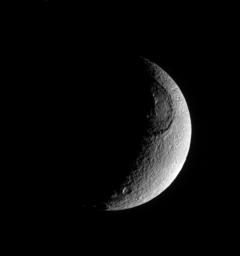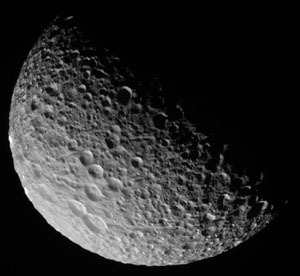New Mimas Image: A World of Hurt

CICLOPS has released this mosaic of Mimas, consisting of three clear filter images taken near closest approach to Mimas. This mosaic is centered near 18.87 North, 238.73 West and has a resolution of 374 m/pixel. This mosaic represents the highest resolution images ever taken of Mimas.
Two prominent features types become apparent in this view. The first are craters. They are everywhere. Clearly, unlike Enceladus, Mimas has had very little internal activity in its history. The surface is so cratered, new craters can only overprint older craters. The craters do show a wide range of morphology due to various states of degradation. While some show signs of internal deformation, or viscous relaxation, which is the dominant form of crater degradation on Enceladus (along with tectonic fracturing), most are degraded by mass wasting. This causes the crater walls to slump down on to the crater floors. This can be seen in most craters larger than 15 km across. The walls on a number of craters are quite tall, up to 6 km in height.
The second prominent feature type are grooves. These features, some over a kilometer deep and 100 km long, maybe caused by the seismic shaking produced by large impacts, like Herschel.
The two largest craters in this view are the 46-km wide Morgan, just above and to the left of center, and the 52-km wide Arthur, near the limb at lower right.







